Discovering the Green Spaces of Dubai: A Comprehensive Guide
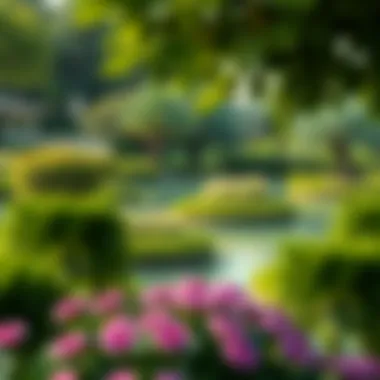
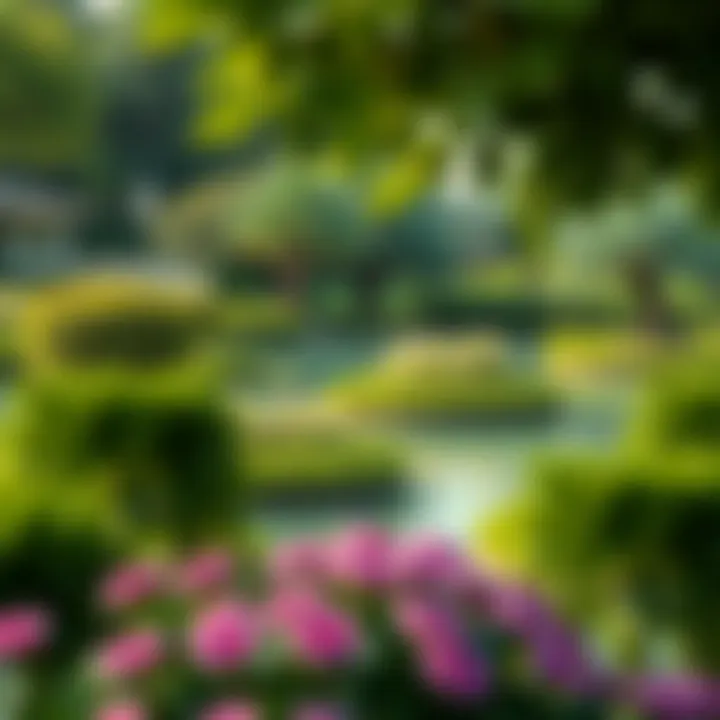
Intro
Dubai, a bustling metropolis known for its futuristic skyline and luxury lifestyle, might not be the first place that comes to mind when one thinks of greenery. However, beneath the glitz and glamour lies a concerted effort to incorporate nature into city life. The sprawling deserts surrounding the city have inspired innovative approaches to greening urban spaces. Parks, gardens, and even vertical forests have found their place here, aiming to provide a breath of fresh air amidst the sprawling urban landscape.
The significance of these green spaces extends beyond mere aesthetics. They play a crucial role in enhancing the quality of life, contributing to mental well-being, and promoting sustainability. Through this guide, we will navigate through various green havens in Dubai, spotlighting their importance and the thoughtful design behind them. Our discussion will explore the diverse types of greenery found in the city, their impact on community life, and the initiatives making these spaces sustainable for the future.
As urbanization continues to rise, the understanding of integrating nature within city planning becomes paramount. Dubai’s commitment to fostering green spaces is a noteworthy aspect, showcasing that even in a rapidly developing urban environment, it is possible to maintain a symbiotic relationship with nature. This guide aims to bring forth the beauty of these green areas, their role in sustainable urban development, and how they contribute to the overall charm of Dubai.
Prologue to Greenery in Dubai
In the heart of one of the world's most bustling cities, the presence of greenery offers a refreshing contrast to the glistening skyscrapers and busy streets of Dubai. The integration of green spaces within this urban framework serves not just aesthetic purposes but works towards a larger objective—enhancing the quality of life for residents and visitors. Beyond visual appeal, these areas present a unique blend of tranquility amid Dubai's vibrant pace, nurturing both community interactions and ecological health.
Dubai's landscape has seen a dramatic transformation over recent decades, evolving from a sparse desert to a bustling metropolis. As a city, it has embraced the need for green spaces, recognizing their importance in promoting sustainability and environmental consciousness. The benefits of greenery extend into various aspects of life, from improving air quality to fostering a sense of well-being among both locals and expatriates.
The inclusion of parks, gardens, and landscaped areas also plays a critical role in preserving biodiversity. These green havens serve as essential habitats for numerous species, contributing to ecological stability within the region. Furthermore, they function as natural cooling systems, helping to regulate the urban heat island effect, often prevalent in cities with extensive concrete structures.
The presence of greenery in Dubai reflects the commitment of the city’s leadership towards creating a livable environment that aligns with global sustainability goals. This endeavor not only enhances the city's aesthetic but has also fostered a sense of community among its diverse inhabitants. As residents gather in parks for recreational activities or simple relaxation, it illustrates how urban greenery can cultivate interactions and strengthen social bonds.
In this exploration of Dubai's greenery, we will dive into specific parks and gardens that stand out, each contributing uniquely to the city’s landscape. We shall investigate their features, activities, and how they cater to different segments of the population, making them accessible to tourists, residents, and families alike. Additionally, we will look into the various sustainability initiatives that underline the importance of these green domains in an ever-evolving urban landscape.
Greenery in Dubai is more than just a visually appealing addition; it's a multidimensional asset that enriches the city's overall fabric. Whether you're seeking a peaceful retreat from the hustle and bustle or a family-friendly environment filled with activities, the parks of Dubai offer something for everyone. Ultimately, they remind us of nature's invaluable role amidst our modern lives.
The Importance of Green Spaces in Urban Environments
The notion of incorporating greenery into urban settings is far more than aesthetic; it's a necessity, especially in bustling metropolises like Dubai. This dynamic city, painted with the broad strokes of modernity, exemplifies the substantial role that green spaces play in improving the quality of life for its residents. Greenery isn’t merely an adornment; it becomes a vital component in creating a balanced urban ecosystem.
Benefits of Urban Greenery
Green spaces provide an array of benefits that extend beyond mere visuals. These areas contribute significantly to the environmental health of a city.
- Air Quality Improvement: Trees and plants act as natural air filters. By absorbing carbon dioxide and releasing oxygen, greenery helps enhance air quality, which is particularly crucial in urban environments plagued by traffic pollution.
- Heat Reduction: Concrete and asphalt absorb heat, raising urban temperatures. Green spaces can lower these temperatures through shade, making cities more livable.
- Biodiversity Promotion: Parks and gardens can serve as habitats for various species, promoting biodiversity in urban landscapes. A diverse ecosystem can also contribute positively to the overall urban environment.
Moreover, the economic value of green spaces cannot be overstated. Neighborhoods with ample greenery tend to see an uptick in property values. A simple stroll in a local park can enhance the appeal of surrounding neighborhoods, enticing potential buyers or renters looking for a serene retreat from the urban rush.
Psychological and Physical Impacts
The effects of green spaces stretch into the psychological and physical realms, enriching the lives of individuals in ways that data often struggles to quantify. Nature has a profoundly positive impact on mental well-being.
Spending time in parks or gardens can lead to reductions in stress levels, anxiety, and symptoms of depression. Studies reveal that individuals surrounded by greenery often exhibit higher levels of happiness compared to those entrenched in urban sprawl without nature.
- Mental Clarity and Focus: Engaging with nature can improve cognitive function, leading to better concentration and clearer thinking. Many people discover that a brief escape to a green space can clear their minds and boost productivity.
- Physical Health Benefits: Access to parks encourages physical activity, promoting healthier lifestyles. Whether it’s jogging along a trail or doing yoga beneath a tree, these activities have lasting impacts on physical health.
"Nature itself is the best physician." - Hippocrates
In sum, integrating greenery into urban environments like Dubai isn’t just a nice-to-have but an essential aspect of fostering healthier, happier communities. As the city continues to grow, recognizing and planning for these vital green spaces becomes increasingly paramount.
Key Greenery Places in Dubai
When one thinks about Dubai, the first images that might pop up could be of towering skyscrapers or bustling shopping malls. However, amidst this urban sprawl lies a treasure trove of greenery. The parks, gardens, and green spaces are essential not just for their beauty but also for the benefits they provide to residents and visitors. These spots serve as sanctuaries for relaxation, recreation, and connection to nature, crucial elements in a fast-paced city. They also promote social interactions and community bonding, making them vital parts of Dubai's urban fabric.
Dubai Miracle Garden
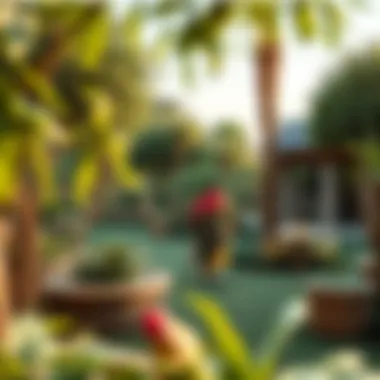
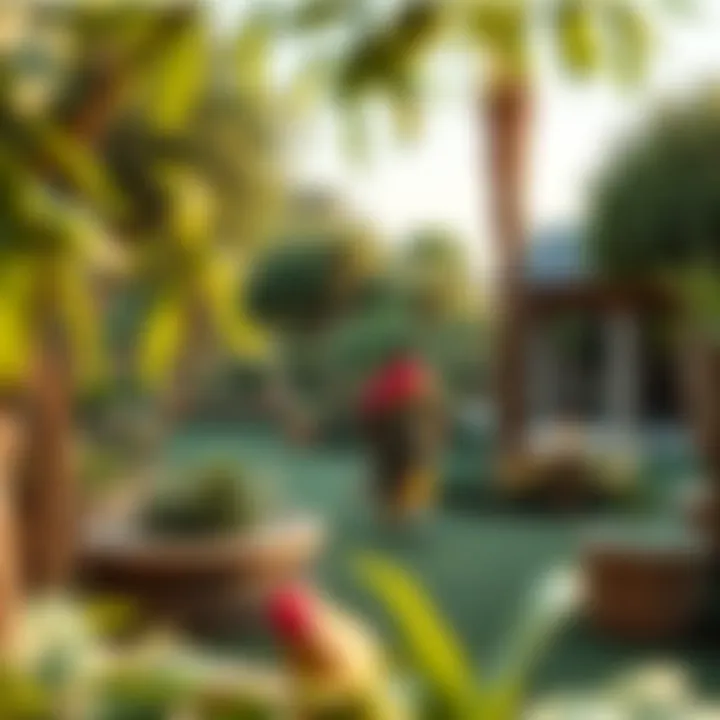
Overview
The Dubai Miracle Garden is a true feast for the eyes. This floral wonderland stretches over 72,000 square meters and boasts more than 150 million flowers. Its contribution to this article is significant; it encapsulates both the artistry of landscaping and the potential of horticulture in a desert environment. The staggering amount of blooms makes it a popular choice for tourists and locals alike. One specific aspect that stands out is the "Heart Tunnel," an enchanting pathway formed entirely of flowers. Walking through it, one can almost forget the bustling city beyond.
Unique Features
What makes the Dubai Miracle Garden particularly captivating is its unique features. Not just a display of natural beauty, it also hosts several themed zones. Each one tells a story, from the Disney Avenue showcasing beloved characters to the Emirates A380, which is a life-sized floral airplane. These distinct areas serve as both educational and entertaining, allowing visitors to see creativity and nature intertwined. However, planning for peak visiting times is essential, as it can become crowded, which might detract from the experience for some.
Visitor Information
In terms of logistics, the Dubai Miracle Garden is open seasonally, generally from November to April. It’s beneficial for visitors to check the timings beforehand. Tickets can be purchased online, which helps avoid long queues. The garden’s layout is user-friendly, but figuring out the best times to visit can vastly improve your experience. Early mornings or late afternoons offer pleasant weather and stunning light for photographs, so consider making those your go-to times.
Al Barsha Pond Park
Layout and Facilities
Al Barsha Pond Park is an oasis of calm, with a layout designed to encourage leisure and recreation. Spanning over 60 hectares, the park is equipped with numerous facilities including walking paths, exercise equipment, and children's playgrounds. Its importance lies in offering a laid-back area for families and individuals alike, providing a space where fitness and relaxation can coexist. The unique feature here is the large pond that acts as a centerpiece, attracting various birds and adding to the park's charm.
Activities
This park isn't just a pretty face; it buzzes with activities. From jogging and cycling to picnicking and kite flying, there's something for everyone. Families can enjoy a variety of recreational activities, while fitness enthusiasts can take advantage of the outdoor gym equipment scattered throughout the park. However, it's worth noting that during weekends, the park can get lively, so if peace and quiet are your priorities, opt for weekday visits.
Accessibility
Accessing Al Barsha Pond Park is straightforward. It's conveniently located, making it a go-to spot for residents in the area. Furthermore, the park features ample parking and easy public transport options, which makes it a popular choice. However, due to its busy nature, finding a parking space during peak hours can sometimes be a challenge, so plan ahead if you're driving there.
Zabeel Park
Park Features
Zabeel Park is a prominent green space in the heart of Dubai and is often regarded as one of the city's most innovative parks. Its features include a vast area for picnics, sculptures, and even a small lake. What stands out is the Dubai Frame, an architectural masterpiece that provides panoramic views of both old and new Dubai. It’s a beneficial spot not only for relaxation but also offers educational displays about the UAE’s history and culture.
Events and Attractions
Throughout the year, Zabeel Park hosts numerous events, including outdoor movie nights and cultural festivals. These events attract a diverse crowd and create a lively atmosphere, enriching the community experience. The unique aspect here is how the park blends entertainment with nature, making it a popular destination for both locals and tourists.
Visitor Tips
For those planning a visit, it’s crucial to check the park’s event calendar. Knowing what’s happening can massively enhance your experience. Additionally, water fountains and shaded areas are spread throughout the park, making hydration and relaxation available even in the heat. Dress comfortably and bring along some snacks, especially if you're there for a few hours.
Dubai Safari Park
Eco-friendly Initiatives
Dubai Safari Park stands out as a model of eco-friendly initiatives, designed to raise awareness about wildlife conservation. With a goal to protect endangered species, the park employs various sustainability practices. One key characteristic of this initiative is its focus on local flora, which supports the indigenous wildlife. Such efforts are essential in educating visitors about the importance of preserving natural habitats, both locally and globally.
Animal Conservation
The park goes beyond mere attractions; it plays a pivotal role in animal conservation. Many of the species present are endangered or threatened, and the park serves as a sanctuary for them. Learning about these animals firsthand enhances the visitor experience while promoting respect for wildlife. However, potential visitors should note the park’s commitment to keeping the natural environments as close to their native habitats as possible, which sometimes requires patience when observing animals.
Visitor Guidelines


For a pleasant visit to Dubai Safari Park, adhering to the guidelines is essential. These may include restrictions on feeding animals, maintaining a respectful distance, and following designated paths. This is crucial not only for visitor safety but also for the welfare of the animals. Being educated about these aspects improves the entire experience, allowing interaction while respecting wildlife.
Safa Park
Recreational Facilities
Safa Park boasts a plethora of recreational facilities that cater to all age groups. With its jogging tracks, child-friendly play areas, and sports facilities, the park embodies a space where fitness meets fun. One key highlight is the lake that adds to the aesthetic appeal while providing several water-based activities, such as paddle boating. This blend of features makes it a popular retreat for both fitness enthusiasts and families.
Landscaping
The landscaping of Safa Park is noteworthy, often inspiring botanical enthusiasts. With a diverse range of plants that flourish in the desert climate, the park is not just visually stunning. It also serves as an example of how green spaces can be the heart of an urban setting. The unique feature lies in its varied landscapes, from flower beds to open lawns, all contributing to a rich and inviting atmosphere.
Events
Safa Park holds various events throughout the year, making it a vibrant part of the community. From fitness challenges to cultural festivals, these happenings draw in crowds and create a lively environment. They enable residents to connect with one another while enjoying the outdoors. Notably, staying updated with event schedules can help visitors partake in activities that suit their interests.
Ultimately, the greenery places in Dubai serve not only as a backdrop to the city's skyline but also as essential components of urban living. They offer a slice of nature amid the progress and foster a sense of community, wellness, and sustainability.
Dubai's Botanical Gardens
Dubai's embrace of vibrant greenery is well embodied by its botanical gardens, which serve as a key focal point for nature enthusiasts. These gardens offer a sanctuary amid the urban buzz, showcasing a remarkable variety of plant species while providing insights into Dubai's commitment to sustainability and education. The blend of local and exotic flora found here not only enriches the landscape but also highlights the city's aspiration to strike a balance between modern living and nature preservation.
Dubai Botanical Garden
Plant Species
The Dubai Botanical Garden boasts a diverse collection of plant species, each selected for its unique attributes. From drought-resistant succulents to flowering trees that thrive in the desert climate, visitors can witness a stunning array of botanical life. A notable example is the native Ghaf tree. This species is cherished for its ability to store water and provide shade, making it an excellent choice for landscaping in arid conditions. Furthermore, the Ghaf's deep roots help bind the soil, preventing erosion.
Such native plants play a crucial role not only in beautifying the environment but also in promoting ecological balance. They attract local wildlife and support biodiversity, critical components of an urban ecosystem. Apart from their ecological benefits, these plants thrive with minimal water, making them ideal for Dubai’s sustainability goals.
"The integration of plant species into our urban settings must reflect the unique environmental challenges we face."
Research Initiatives
Research initiatives at the Dubai Botanical Garden focus on cultivating sustainability. They gather data on plant growth, adaptation to local climates, and conservation strategies. One remarkable project involves collaboration with local universities to study the effects of climate change on endemic plant species. Such initiatives not only raise awareness about the importance of biodiversity but also contribute directly to developing best practices in landscaping.
The research, while benefiting the botanical garden itself, spills over to community engagement, informing citizens about sustainable gardening methods and eco-friendly practices. This hands-on knowledge equips people with the means to foster green spaces in their homes, reinforcing Dubai’s vision of a greener, more sustainable future.
Educational Programs in Green Spaces
Educational programs within Dubai's green spaces work hand in hand with botanical gardens to enlighten residents about ecology and sustainability. Workshops, guided tours, and interactive sessions are arranged, appealing to both adults and children. These programs aim to raise awareness about the importance of preserving natural habitats and understanding local flora and fauna.
Such educational efforts can be instrumental in shaping a generation that respects nature and understands its invaluable contributions to a livable city. The gardens become classrooms where the lessons extend beyond traditional curricula, crafting an informed public ready to engage with their environment thoughtfully.
Sustainable Landscaping Practices
Sustainable landscaping practices are paramount in shaping Dubai's green initiatives. These methods not only focus on aesthetic appeal but also on long-term ecological balance. In a city where the desert's harsh climate predominates, effective landscaping can make a significant impact on the environment. By incorporating sustainable practices, Dubai is making strides towards enhancing biodiversity, conserving water, and minimizing the urban heat island effect.
Efforts in Water Conservation
Water conservation is a hot button issue in arid regions like Dubai. The landscape design reflects a conscious effort to use water judiciously. Techniques such as drip irrigation and xeriscaping dramatically reduce water consumption.
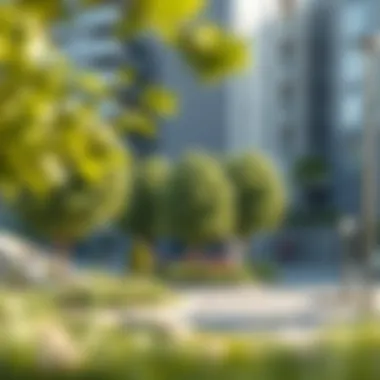

Drip irrigation systems, which deliver water directly to the roots of plants, ensure minimal evaporation and runoff. This method allows plants to thrive even under Dubai's scorching sun.
Moreover, Dubai has made substantial investments in recycled water systems. Treated wastewater is often reused for landscaping and irrigation purposes. This practice supports green spaces and gardens without overburdening the already limited freshwater supply. According to the Dubai Electricity and Water Authority, around 25% of water consumed is recycled, benefiting parks and green areas across the city.
Native Plant Utilization
Another crucial aspect of sustainable landscaping in Dubai is the utilization of native plant species. Native plants are well-adapted to the local climate and soil conditions, requiring less water and maintenance compared to non-native varieties.
By encouraging the use of indigenous flora, Dubai aims to create ecosystems that foster local wildlife and promote biodiversity. For instance, plants like Ghaf and Date Palms play a vital role in supporting the region's ecological identity.
Additionally, plants native to the UAE often feature drought-resistant characteristics, providing lush greenery without straining resources. This approach not only enhances the aesthetic value of urban landscapes but also significantly contributes to environmental sustainability.
"In urban areas, integrating nature serves not only to uplift our surroundings but also to protect our essential resources."
Future of Green Spaces in Dubai
The development of greenery in urban environments remains crucial as the world grapples with rapid advancements. In Dubai, dabbling in green spaces is more than just an ecological trend; it’s becoming a foundational pillar for community well-being and environmental health. The importance of the future of green spaces in this dazzling city is multifaceted, encompassing aesthetic beauty, ecological balance, and enhanced urban living for everyone.
Government Initiatives
Dubai’s government is at the forefront of promoting sustainability through its commitment to enhancing green spaces. The Dubai 2040 Urban Master Plan signals this dedication, aiming to increase the city's greenery to more than 60 percent in developed areas. This means not only parks but also urban gardens, rooftop greenery, and tree-lined streets. Initiatives like the Dubai Green Building Code ensure that new constructions incorporate eco-friendly elements, thus integrating greenery into the architecture right from the blueprint stage.
Key government projects in this realm include:
- Dubai Garden Glow – a stunning amalgamation of art and nature, showcasing vibrant displays made from recycled materials.
- Dubai's Urban Forestry Strategy – which aims to plant 50 million trees across the emirate, significantly boosting biodiversity.
- Green Roofs Initiative – encouraging more buildings to adopt green roofs as a means to insulate buildings and provide natural habitats..
The establishment of the Dubai Environment Department has also played a significant role. They facilitate community events focused on environmental education, which empower residents to participate actively in maintaining natural beauty. Thanks to these efforts, Dubai’s urban landscape is evolving, balancing the shimmering skyscrapers with lush greenery, promising a healthier future.
Community Involvement
Community engagement is a cornerstone in ensuring the success and longevity of green spaces. Local community groups and residents are getting more involved in volunteering for maintenance and planting activities. Programs like Adopt-a-Park encourage citizens to take pride in their surroundings, thus fostering a sense of ownership and stewardship.
Additionally, schools are increasingly introducing environmental curricula, emphasizing the importance of greenery and how to care for local ecosystems. This grassroots education leads to a new generation that values and nurtures the environment.
There are myriad ways community members can get involved:
- Monthly Clean-Up Drives – regularly scheduled to keep parks clean and welcoming.
- Tree Planting Days – inviting families to join in, imparting knowledge about local flora.
- Public Workshops and Events – hosted at local parks, offering insights into sustainable gardening and landscaping.
Engaging the community not only enhances the health of these green spaces but also builds bonds among residents. People start chatting as they dig, ending up sharing stories, gradually creating a close-knit community around the shared love of nature. This sense of belonging amidst a city that is constantly changing is invaluable.
Through effective government policies and vibrant community engagement, the future of green spaces in Dubai is not merely a dream but an attainable vision, steering the city toward a more sustainable and green tomorrow.
Closure
In wrapping up our exploration of greenery within Dubai, it’s essential to underline the transformative power of green spaces in a fast-paced urban environment. The various parks, gardens, and green areas play a crucial role, not just in beautifying the city but also in promoting sustainable practices and enhancing the quality of life for all who reside in or visit this dynamic metropolis.
Dubai’s strategy to integrate nature into its urban planning cannot be overstated. The benefits are manifold:
- Mental well-being: Access to greenery has been linked to reduced stress levels and improved mental health. Just a stroll through Al Barsha Pond Park or the Dubai Miracle Garden can provide a much-needed respite from the city's hustle and bustle.
- Environmental impact: Green spaces contribute to biodiversity. They serve as habitats for various species and help mitigate urban heat effects. This invites nature into daily life, which is critical in a desert environment like Dubai's.
- Social interaction: Parks like Zabeel Park or Safa Park are meeting points for families and friends, fostering community bonds. They become hubs where people can engage in recreational activities, celebrate events, and simply enjoy nature together.
While the efforts made thus far are commendable, it’s important to focus on continuous improvement. The government and community need to work hand-in-hand to expand these green initiatives. This is especially true as the city grows, where maintaining ecological balance will be pivotal in ensuring a high quality of life for future generations.
"The future of urban living lies in our ability to harmoniously blend greenery within our cities."
Investors, expatriates, agents, buyers, and renters take note: the inclusion of these green spaces is not only attractive from a lifestyle perspective but also adds significant value to properties. They enhance the desirability of neighborhoods and provide a crucial selling point for any real estate transaction in the area.
In essence, the green spaces of Dubai are more than just parks or gardens; they are lifelines that connect the urban pulse of the city with nature. Embracing and expanding this greenery will undeniably shape the future of urban living, positioning Dubai as a model for other cities worldwide. Consider this as an invitation to not only appreciate but also actively participate in the cultivation and protection of these vital green patches in the heart of the city.



